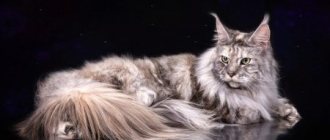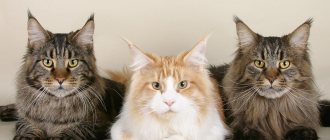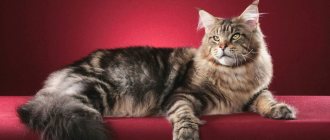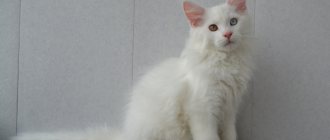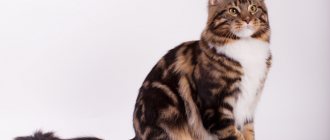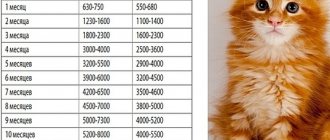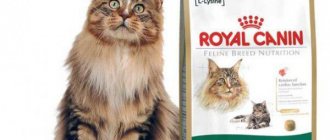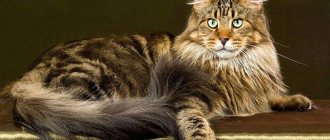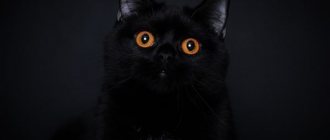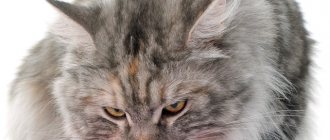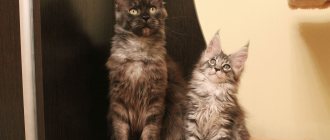From a genetic point of view, Maine Coons have two main coat colors – red and black. All other shades are different variations of the basic ones. All the variety of colors and patterns appears due to the special distribution of hair pigment, which determines the color of the animal.
Determining the hereditary color allows you to find out which cat's offspring will appear. Maine Coons are no exception here. To do this, breeders use special tables with formulas that will tell the color of future kittens. Based on them, you can decide how to cross the adults to get the desired result.
Maine Coons of different shades.
Traditional Maine Coon colors: photos and descriptions
There are several types of coat patterns called tabby.
They all have their own patterns. Tabby was inherited from the wild ancestors of modern domestic Maine Coons. Their distinctive feature is the letter “M”, which is visible in the area of the cat’s forehead and eyes with light or dark lines. There are three types of tabby:
- Tigers. The stripes on the body are parallel to each other.
- Spotted. There are spots of dark and light shades on the sides.
- Classic. Similar to the pattern of marble.
There is also a fourth type - ticked, but it is not typical for this breed. It is usually found in the Abyssinian breed and other oriental cats. It may appear in isolated coon individuals.
Often there are uniform colors in the same range; they are called solid or in the English version - solid (uniform). In this case, the tabby can be almost invisible. Often found in cats that are black in color. The darker the cat, the weaker the pattern of its coat appears. Tabby is especially pronounced in cats with fur of red (red) shades. Solids can be in the following palette:
- black;
- cream;
- red;
- smoky;
- blue.
Smoky gray and blue are of particular interest to Maine Coon breeders, as they are very rare for representatives of this breed. The gallery below shows photos of popular colors.
Maine Coon color calculator
To understand what color will result from crossing animals, breeders use a calculator table. With its help, you can predict with a very high probability what color the offspring of a thoroughbred couple will inherit.
How the coat colors of Maine Coon offspring interbreed.
This is, of course, not a guaranteed result, as it is impossible to calculate the exact genetic combination a kitten will inherit. From time to time, extremely interesting representatives of coons are born, having, for example, tortoiseshell tones, which is very rare for this breed. It has been noticed that most of these individuals are female.
Gray Maine Coon
Gray or blue colors are considered rare for this breed.
An even color of blue shades is a rare occurrence. A smoky shade is usually found. These cats look special; their color gives them their aristocratic charm. If a cat is exactly like this, it means that the gene responsible for the presence of a pattern on the body has been completely suppressed.
Blue tones are specially developed through selective breeding. This takes a lot of time and effort from breeders. The letter “A” is placed in the passport of such a kuna. If the cat has two-color fur, the code “03” is added to the letter designation.
Painted cats
The coat pattern often found among Maines is called tabby or, if pronounced in English, tabby. Scientists claim that tabby is present in the genotype of all cats without exception - they inherited it from their wild forest ancestors. The pattern is obtained due to the fact that, under the influence of a certain gene, the color of cat hair is zoned. Simply put, this means that the hair is not monochrome, but striped, as can be seen upon closer inspection.
Depending on how the light and dark areas are located on an individual hair, one or another pattern is formed on the wool. Tabby is divided into various "patterns", for example:
- brindle color is continuous parallel stripes;
- spotted – intermittent stripes;
- classic - marble stains.
The latter looks best on a black Maine Coon; the black tabby Maine looks surprisingly noble.
tabby color merle
tabby brindle color
tabby color spotted
Elegant ticking
A type of pattern that is uncharacteristic for Maines is ticked. With this color, the entire mass of the coat consists of striped (ticked) hair in the absence of a pronounced pattern (its residual signs can be on the legs, chest and forehead). Ticking is more common among Abyssinian cats; Maine Coons with this color are very rare. These cats look very elegant, especially the black ticked one.
color silver ticked
color red ticked
color ticked
The charm of diversity
Tortoiseshell color is a good omen - many believe that multi-colored cats bring their owners good luck in all endeavors. This may not be true, but they definitely bring joy and aesthetic pleasure.
The pied Maine Coon, especially with “smoke,” is incredibly picturesque. And in this case, it is not so important whether it is a classic “tortoiseshell” (randomly scattered spots of any color except white), or spotted brown, reminiscent of autumn foliage in color, or creamy blue tortoiseshell, combining delicate pastel shades. Without exception, all the “turtles” are magnificent!
tortoiseshell color
smoky tortoiseshell color
color tortoiseshell bicolor
The rarest and most expensive Maine Coon colors
Each breed has rare colors that are not often seen. Maine Coons are no exception. This breed has its own rare shades:
- Brown with spots. These kittens have a color similar to autumn foliage.
- Creamy blue. Looks like tortoiseshell with rare pastel shades.
- Chintz. This is a unique coloring for coons. The base is red, diluted with black tones with white splashes.
- Watered down chintz. There are cream-colored spots on a white background, and blue colors have a solid coloring.
- Spotted with white spots.
Such colors are not typical for coons and are rare.
Smoky
Such cats can be black or blue. The intensity of the haze determines the subspecies:
| Name | Description |
| Chinchilla | Only the tip of the hair is pigmented |
| Shaded | color has a quarter of the hair |
| Smoke | Only the root of the hair is colored white, the main part has black or blue pigments |
| True smoke | Half of the hair has pigmentation |
| Silver | the hair is white at the root, the rest is light silver |
| Cream | at birth, the coat is uniform in color, but gradually becomes unevenly pigmented |
| Classic wild | brindle, marbled black, spotted |
Smoky cats are characterized by white roots. Gray is usually found in monochromatic animals.
Chocolate
The wool is colored brown, warm, rich. The presence of inclusions of other shades or patterns is not allowed. The hairs have an even distribution of pigment. Unlike red tones, it is darker and deeper. Quite rare in breeding. The paw pads and nose also have brown tones.
Classic wild
This color suggests the presence of a pattern on the animal's fur. They can be of different types:
- brindle;
- marble black;
- spotted.
These are the main colors of coons that were common among their wild ancestors.
Peach
These cats have similar features to their cream counterparts. These can be yellow, orange shades characteristic of tabby coons.
Black
Black monochromatic coloring is extremely rare for this breed.
Each black coon has a different color depth and saturation, so it is impossible to find two identical black cats. Usually, this color hides the pattern on the coat. In small kittens it can be difficult to see, but as they grow older it is completely hidden. The cat becomes completely monochrome. An animal with black fur looks regal, luxurious, reminiscent of a majestic panther in appearance.
Black and white
Cats with this coloration have different proportions of these colors:
- Black with white spots. There are several small spots of white on the fur.
- White medallion. A white spot is located on the chest of the animal, reminiscent of decoration.
- White gloves. The cat has black and only white paws of the animal.
- White tuxedo. There is a white shirtfront on the neck, and the paws are also white.
- Bicolor. Black and white in a 1/1 ratio.
- Harlequin. The color is predominantly white with a few black spots.
- Wang. The head and tail are painted black. The rest of the body is white.
What is the danger of white color
White Coons have a predisposition to complete deafness.
It is found in this color much more often than in animals with a different shade of fur. However, there is no need to be upset by this fact. Deaf individuals feel great.
They live well in the house, and are oriented to the area no worse than healthy ones. Their hearing loss is compensated by vision and a keen sense of smell. People who do not know about cat deafness will not guess about it.
Cream
This shade is obtained by lightening the red. The animals are colored in shades similar to raw ginger. When crossing, individuals with genetically weakly expressed pigment in the pedigree are preferred. However, theoretically, even Black Solid Maine Coons can produce cream-colored offspring.
How would this be scientific?
The types of colors of Maine Coon cats in the unified international EMS system are assigned codes consisting of letters and numbers, each of which indicates a particular color characteristic:
- main color
| n | black |
| a | blue |
| d | red |
| e | cream |
| f | black turtle |
| g | blue cream turtle |
| s | silver or smoke (manifestation of one gene, but patterned individuals are called silver, and solid ones “smoky”) |
| w | white (may be due to the manifestation of different genes) |
- presence and type of white spots
| 01 | van (white individual with a small spot, spots of the main color) |
| 02 | harlequin (two thirds of the individual is white) |
| 03 | two-color or bicolor |
| 09 | with white (less than half white) |
- the presence of a pattern on the fur and its appearance
| 22 | marbled or classic tabby (“M” on the forehead and beautiful “butterflies” on the sides of the individual) |
| 23 | brindle tabby or mackerel (“M” on the forehead and stripes all over the body) |
| 24 | spotted (Maine Coons have torn tiger or merle) |
| 21 | agouti factor (recorded when it is clear that the animal is a tabby, but it is not clear what kind of pattern it is) |
| 11 | shaded (tabby on silver with a blurry pattern on the body) |
| 12 | chinchilla - black series of colors, cameo - red series (very strong silver, in which the animal looks almost white with a slight touch of the main tone, sometimes completely white) |
- eye color (not always indicated)
| 61 | blue - blue |
| 62 | yellow, golden - yellow, orange, golden, etc. |
| 63 | oddeyed - disagreement |
| 64 | green - green |
In terms of primary color, the following Maine Coon colors are allowed: black, white, red, blue, cream, cream-blue and tortoiseshell. Shades of chocolate and cinnamon are strictly prohibited for Maine Coons.
Tortoiseshell
The tortoiseshell Maine Coon comes in two types – torby and torty.
The first type is a combination of red and black shades of wool, expressed in a dark brown color. The torti has a greater addition of red with dark cream. Of particular interest is the fact that tortoiseshell coloring is most often found in cats.
The probability of a male being born with this coloring is approximately 1 in 1000.
On such cats, markings of different sizes and shapes are more clearly visible. Based on the severity of these spots, several colors can be distinguished:
- calico;
- flap;
- chintz.
These cats are characterized by the presence of red shades of fur. The classic color, consisting of three colors, is obtained by mixing black and red. This makes the coat more variegated. There are also several tortoiseshell shades.
Scaly tortoiseshell
Reminiscent of fish scales, the order of spots on the body is checkerboard. These spots alternate in black and red tones and are unevenly distributed. Any one of the colors may predominate.
Calico and solid tortoiseshell (patchwork)
The spots of black and red color resemble flaps. They have defined boundaries and can overlap each other. If the wool has white patches, this color is called “tortoiseshell white” or calico. Red and black spots are solid in color and clearly visible on the animal’s body.
Patterned tortoiseshell
Multi-colored spots have a pronounced pattern. These may be spots or stripes, but marbled colors are also common. There may be small white spots. In this case, it is fashionable to say that the color is spotted tabby or tabby with white spots.
Tortoiseshell colors
The tortoiseshell color of the Maine Coon is associated with the history and origin of the breed. Since ancient times, these giant cats have had to adapt to survive in North America, where winters are often frosty and long. It was the tortoiseshell colors of the “fur coat” that served as a real salvation for cats, because with its help they could hide unnoticed in snowy thickets. The tortoiseshell color on the coat of Maine Coons remains quite popular to this day.
Marble colors
Can be cold or warm tones. The first has more gray tones, while the warm one is dominated by brown shades. These stains sparkle in the sun in a special way, which many people like. Such stains can be drawn in different ways - stripes, spots, contours. Such spots can be well defined, then they are more reminiscent of a tortoiseshell color. Marble coloring has more diffuse, blurred borders of spots.
Bicolor individuals
Ticked
The ticked color is characteristic of animals of other breeds, but occasionally occurs in Maine Coons.
Other names are agouti or Abessinian color. Such pets are classified as tabby. Cats with this pattern are characterized by black parallel stripes on the upper part of the face. But there are no patterns on the body and there is only a single dark shade. Often this type of coloring is found in other breeds, is not recognized in Maine Coons and is not included in the classification of colors of this type of animal.
brindle tabby
This ticked color in Maine Coons is considered a wild color: the pet has vertical elongated stripes throughout the body. Parallel interrupted stripes are less common, but such a pattern is not considered defective and is recognized by the classification. Less commonly, peach-colored tri-colored tabbies are combined with small spots on the cat's ribs. The pattern is sometimes called "mackerel" due to its resemblance to the fish of the same name. The lighter the cat's coat, the more noticeable the tabby.
Tabby
This type of coloring is present in all representatives of the Maine Coon breed, but may not be expressed in a bright form. This color is a genetic predisposition. A cat's hair has its own zoning or striping. The wild ancestors were tabbies, which was inherited by modern representatives. There are various options for this design.
Classic, spotted and brindle tabby
Characterized by wide stripes of a spiral shape. They are usually located on the sides of the animal, and can resemble marble stains. Spotted tabbies have intermittent stripes or spots of color throughout the animal's body. The brindle tabby is similar to the brindle coloring - vertical stripes along the entire length of the body.
Ticked Tabby
These cats have no stripes or spots at all. The fur has a peculiar pattern on the face, paws, and chest. Ticking is the distribution of pigment along the hair. The tip has a rich shade, gradually losing brightness towards its root.
Types of colors
The Maine Coon cat breed comes in a wide range of shades. Among the animals there are individuals with uniform coats, with spots and stripes of unusual shades. There are classic colors that are present in the EMS system with codes and are designated by the letter n. Traditionally it is believed that natural colors are red and black. The remaining shades appeared in the process of mixing the main range. White coloring is considered a complete absence of color. This is an expensive breed that requires careful personal care: the pet must be vaccinated, shown to the veterinarian on time, and fed thoroughly.
The following types of flowers are distinguished:
- cream Maine Coon;
- blue smoke;
- brindle;
- turtle;
- peach;
- calico;
- ashen;
- Brown color;
- black ticked;
- Maine Coon Blue Solid;
- red marble;
- tortoiseshell color.
The shade of a pet's coat is determined genetically.
Random color combination
Sometimes there are situations when the maine has a color that does not fit any of the color types. For this purpose, its own classification was created. These colors can be called:
- Brown tabby with spots. Such an animal has spots of red and brown.
- Blue spotted tabby. The cat in this case has cream and blue stripes on its body.
- Creamy blue. The spots are scattered in a chaotic manner throughout the body. This color is sometimes called a blue turtle.
- Creamy blue, white.
- Spotted tabby with white spots. The color is similar to the previous one, but there are inclusions of white spots.
Such combinations are also rare.
Bicolor or not bicolor?
The main color of the maine can be complemented by clearly defined white spots of different sizes. Some owners call any white-spotted cat “bicolor,” but this is not entirely true. White spots also have their own official names:
- “buttons” - small spots all over the body;
- “gloves” - white paw tips;
- “medallion” - a spot on the chest;
- “harlequin” - white background with large colored spots;
- "van" - predominantly white with color only on the head and tail;
- “tuxedo” (felinology does not formally use this definition, but it is widely used among cat owners) – white legs and chest, contrasting with the main color.
And bicolor is the official name of a color in which white and colored wool are present in a ratio of 50x50.
color black bicolor
color red bicolor
color blue bicolor
Unrecognized
Chocolate, gold, and lilac colors are not allowed at specialized exhibitions. Coons with Siamese coat color are also not recognized. There are patterns that are considered unrecognized for the Coons. These can be called:
- faun;
- cinnamon;
- point;
- sorrel;
- acromelanic color.
The coat color of Maine Coons is distinguished by a huge variety of colors and their combinations. The eyes of purebred animals must match the color of their fur. They can be blue (only pure white wool), green, yellow. White individuals may have different colored eyes (blue and green).
Determining the color of future offspring
To determine what color will be obtained when crossing animals of a certain color, a special color table is used. There are also special color calculators on the Internet that automatically calculate the color of future offspring. To do this you need to specify:
- presence of silver, white spots;
- EMS breed coding;
- main color;
- drawing;
- gender of both parent animals.
By the way, the gender of the animal is also coded. The cat is designated by the numbers 1.0, the cat is assigned the code 0.1.
In general, the health of Maine Coons has no connection with color, but there are exceptions. So, you cannot cross white individuals.
The colors of Maine Coon cats come in a wide range of colors. Amazing combinations of patterns and colors, stripes and spots give their magnificent wool a special sophistication and original appearance. The color of the Maine Coon to a certain extent determines the price, but is not the determining factor. To breed good offspring, the more important parameter is the breed type of the cat and its health status.
EMS color code
The International Association of Felinologists has developed a table that includes color options recognized by professional breeders. We need such a systematic collection for the convenience of making entries in the pedigree of the animal, bringing information about the breed to a single standard.
Unified table of coat colors according to EMS coding.
Thus, all colors not included in the standard coding are considered coat color defects. Individuals with unrecognized colors are not allowed at exhibitions and are not used in breeding.
However, they are suitable for home keeping in the same way as those with coat colors included in the table. Representatives of this breed have many genetically determined color options. Each Maine Coon is beautiful in its own way, no matter what color nature gave it.
"Smoky" beauties
“Smoky” cats look very impressive, especially when their shiny, well-groomed fur sways and shimmers in the light. The smoky color is due to the fact that the root of each cat’s hair is white, and the end is colored, and with different intensities. For example, in a Maine Coon, black smoke has a strong base color.
In international coding, this sign is marked with the Latin letter S, which, depending on the interpretation, can mean smoke (smoke) or silver (silver). According to the degree of hair coloring, smokiness is divided into the following categories:
- regular smoke - half the hair is dyed;
- shaded smoke - a quarter of the hair is dyed;
- chinchilla – one-eighth of the hair is dyed.
color blue smoke
color red smoke
color black smoke
Exquisite Silver
The silver coon stands somewhat apart in this gradation. This is such a light coat color that it is very difficult to distinguish it from white, especially in childhood. A silver Maine Coon kitten is usually identified by the color of its iris: a white Maine most likely has blue eyes, and a silver Maine has green eyes. Over time, the silver coat darkens a little, and a pattern called “tabby” (discussed below) becomes more pronounced on it. Cats of this color are generally very attractive and unusual, but the so-called “marble on silver” looks especially elegant, when wide spiral stripes are run along the silvery fur, reminiscent of marble patterns.
color silver tabby
color tortoiseshell silver bicolor
color red silver
Classification: basic principles
The Maine Coon color type consists of three components:
- the color of the wool itself
- absence or presence of a pattern on the cover
- presence of spots, their color and size.
As for the classic shade of wool, felinology claims that there can only be two original colors: black and red. By red Maine Coons we mean cats that are commonly called red in everyday life. The remaining existing variations in shades are the result of oxidation or lightening of the pigment under the influence of external factors and the genetic characteristics of a particular individual.
The pattern on the fur of Maine Coons can be very diverse, most often it is a combination of stripes of different thicknesses and lengths, sometimes turning into curls.
The spots can either complement the line pattern or be a separate part of the coat color. The absence of lines with a large number of randomly located spots is a sign of the tortoiseshell color of the Maine Coon.
Determining the color of a Maine Coon requires a lot of experience and both the ability to distinguish between principles common to all cat breeds and knowledge of genetics and the characteristics of a particular breed. To simplify this task, an EMS table was created within the framework of felinology, which includes all possible color options for purebred Maine Coons.
© shutterstock
Tabby: features and differences
The presence of a pattern on the body is typical for many breeds. But a Maine Coon tabby must meet one of the following requirements:
- the lines on the forehead form something like the letter “M”
- on the cheeks there are stripes of a darker shade than the main color
- around the eyes and nose there are clear stripes outlining their outline
- on the neck there are several stripes in the form of a kind of necklace
- the paws are entwined with a pattern of contrasting dark stripes
- on the stomach there is a pattern of spots resembling buttons.
The specific color of the tabby and the specific pattern depend on the genotype of the father and mother of the individual.
Contents: how to care for a cat?
After the owners have brought the pet home, it is not recommended to carry out bathing procedures for several weeks in order to protect the animal from stress. You can only comb the coat using a hard specialized brush once a week. It is necessary to purchase a scratching post for your pet, making sure to pay attention to the strength and height of the product. After adaptation, it is important to bathe the animal. The adoption of water procedures should be carried out with shampoos and conditioners, after which the pet must be wiped dry with a warm terry towel. If there are fleas in your cat's fur, or to prevent their appearance, you should use specialized medications. Experts do not recommend bathing Maine Coons with black smoke before and after vaccination and if the cat has had any illness. It is necessary to clean the eyes and ears as they become dirty with cotton pads or a soft cloth moistened with warm water.
